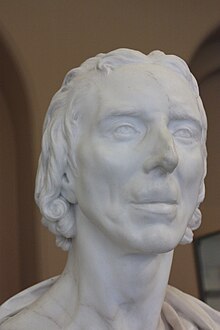Thomas Banks

Multi tool use

Engraving by Benjamin Smith of Banks' sculpture Shakespeare attended by Painting and Poetry at the entrance to the Boydell Shakespeare Gallery. The sculpture in now in the former garden of Shakespeare's home New Place in Stratford.

Alcyone and Ceyx marble bas relief, originally at Parlington Hall, Aberford, removed to Lotherton Hall sometime after 1905.

Dr Anthony Addington by Thomas Banks, 1790, Victoria and Albert Museum

Eyre Coote Memorial at Westminster Abbey by Thomas Banks
Thomas Banks RA (29 December 1735 – 2 February 1805) was an important 18th-century English sculptor.
Contents
1 Life
2 Works
3 Memorials
4 References
Life
The son of William Banks, a surveyor who was land steward to the Duke of Beaufort, he was born in London. He was educated at Ross-on-Wye.
He was taught drawing by his father, and from 1750 to 1756 was apprenticed to a woodcarver, William Barlow, in London. In his spare time he worked at sculpture, spending his evenings in the studio of the Flemish émigré sculptor Peter Scheemakers. During this period he is known to have worked for the architect William Kent. Before 1772, when he obtained a travelling studentship given by the Royal Academy and proceeded to Rome, he had already exhibited several fine works.[1]
Returning to England in 1779 he found that the taste for classic poetry, ever the source of his inspiration, no longer existed, and he spent two years in Saint Petersburg, being employed by the empress Catherine the Great, who purchased his Cupid Tormenting a Butterfly. On his return he modelled his colossal Achilles Mourning the Loss of Briseis, a work full of force and passion; and then he was elected, in 1784, an associate of the Royal Academy and in the following year a full member.[1]
Banks died in London on 2 February 1805.[1] He is buried in Paddington Churchyard.
A monument to his memory was also erected in Westminster Abbey.[2]
Works
Among other works in St Paul's Cathedral are the monuments to Captain George Blagden Westcott and Captain Richard Burgess, and in Westminster Abbey to Sir Eyre Coote, General Loten, Sir Clifton Wintringham and William Woollett. His bronze bust of Warren Hastings is in the National Portrait Gallery.[3]
Banks's best-known work is perhaps the colossal group of Shakespeare Attended by Painting and Poetry[4], which since 1871 has been placed in the garden of New Place, Stratford-upon-Avon.[5] The high-relief sculpture was commissioned in 1788 to be placed in a recess in the upper façade of John Boydell's new Shakespeare Gallery in Pall Mall.[citation needed] Banks was paid 500 guineas for the group which depicts Shakespeare, reclining against a rock, between the Dramatic Muse and the Genius of Painting.[6] Beneath it was panelled pedestal inscribed "He was a Man, take him for all in all, I shall not look upon his like again".[7] The sculpture remained in Pall Mall until the building was demolished in 1868 or 1869, when it was moved to New Place.[8]
One of his most bizarre works is "Anatomical Crucifixion" (1801) held in the Hunterian (Anatomical) Museum in London. This shows a dissected body nailed to a cross.
Memorials
See Gunnis.[9]

Memorial to Bishop Law in Carlisle Cathedral by Thomas Banks
Isaac Watts, Westminster Abbey (1774)- Bishop Thomas Newton, St. Mary-le-Bow (1782)
Sir Eyre Coote, Westminster Abbey (1783)
Dean Smith, Chester Cathedral (1787)- John Heaviside the elder, Hatfield, Hertfordshire (1787)
Bishop Edmund Law, Carlisle Cathedral (1787)- Robert Markham, St Marys, Whitechapel, London (1788)
Giuseppe Baretti, Marylebone Chapel (1789)
Philip Yorke, 2nd Earl of Hardwicke, Flitton, Bedfordshire (1790)- Samuel Northcote, St Andrews, Plymouth (1791)
William Woollett, Westminster Abbey (1791)
Shukburgh Ashby, Hungarton, Leicestershire (1792)- Penelope Boothby, Ashbourne, Derby (1793)
Joseph Hurlock FRS, Stoke Newington Parish Church (1793)- Anna Matthews, Chester Cathedral (1793)
Joan Gideon Loten, Westminster Abbey (1793)
Sir Clifton Wintringham, Westminster Abbey (1794)- Mrs Halifax, Ewell, Surrey (1795)
- Margaret Petrie, Lewisham Parish Church (1795)
Stephen Storace, Marylebone Parish Church (1796)- Colonel Thomas Kyd, memorial in Calcutta Botanical Gardens, India (1796)
- Cornelia Millbank, Croft, Yorkshire (1796)
- John Halliday, Halesowen, Worcestershire (1797)
- John Clarke, Ickenham, Middlesex, (1800)
- Captain Richard Burgess, St Paul's Cathedral (1802)
- Captain George Blagden Westcott, St Paul's Cathedral (1805)
References
^ abc Anonymous 1911.
^ Dictionary of British Sculptors, 1660–1851, Rupert Gunnis
^ Dictionary of British Sculptors, 1660–1851, Peter Gunnis
^ https://books.google.com/books?id=zZM3AAAAIAAJ&pg=PA74 Annals of Thomas Banks, Sculptor, Royal Academician
By Thomas Banks, 1938, p. 74.
^ https://historicengland.org.uk/listing/the-list/list-entry/1298541
^ Sheppard 1960, pp. 325–338 cites Signature, new series, 1949, No. 8, pp. 3–22.
^ Sheppard 1960, pp. 325–338 states "Illustrations of the exterior of the gallery are in B.M., Crace Views, portfolio XI, sheet 20, No. 47; Soane Museum, Soane drawings, drawer 18, set 7, No. 14; C. F. Bell, Annals of Thomas Banks, 1938, Plate XIV".
^ Sheppard 1960, pp. 325–338.
^ Dictionary of British Sculptors, 1660–1851, Rupert Gunnis
Works cited
Sheppard, F. H. W., ed. (1960), "Pall Mall, North Side, Past Buildings", Survey of London: volumes 29 and 30: St James Westminster, Part 1, English Heritage, pp. 325–338, retrieved 16 November 2007.mw-parser-output cite.citation{font-style:inherit}.mw-parser-output q{quotes:"""""""'""'"}.mw-parser-output code.cs1-code{color:inherit;background:inherit;border:inherit;padding:inherit}.mw-parser-output .cs1-lock-free a{background:url("//upload.wikimedia.org/wikipedia/commons/thumb/6/65/Lock-green.svg/9px-Lock-green.svg.png")no-repeat;background-position:right .1em center}.mw-parser-output .cs1-lock-limited a,.mw-parser-output .cs1-lock-registration a{background:url("//upload.wikimedia.org/wikipedia/commons/thumb/d/d6/Lock-gray-alt-2.svg/9px-Lock-gray-alt-2.svg.png")no-repeat;background-position:right .1em center}.mw-parser-output .cs1-lock-subscription a{background:url("//upload.wikimedia.org/wikipedia/commons/thumb/a/aa/Lock-red-alt-2.svg/9px-Lock-red-alt-2.svg.png")no-repeat;background-position:right .1em center}.mw-parser-output .cs1-subscription,.mw-parser-output .cs1-registration{color:#555}.mw-parser-output .cs1-subscription span,.mw-parser-output .cs1-registration span{border-bottom:1px dotted;cursor:help}.mw-parser-output .cs1-hidden-error{display:none;font-size:100%}.mw-parser-output .cs1-visible-error{font-size:100%}.mw-parser-output .cs1-subscription,.mw-parser-output .cs1-registration,.mw-parser-output .cs1-format{font-size:95%}.mw-parser-output .cs1-kern-left,.mw-parser-output .cs1-kern-wl-left{padding-left:0.2em}.mw-parser-output .cs1-kern-right,.mw-parser-output .cs1-kern-wl-right{padding-right:0.2em}
Attribution
 This article incorporates text from a publication now in the public domain: Anonymous (1911). "Banks, Thomas". In Chisholm, Hugh. Encyclopædia Britannica (11th ed.). Cambridge University Press.
This article incorporates text from a publication now in the public domain: Anonymous (1911). "Banks, Thomas". In Chisholm, Hugh. Encyclopædia Britannica (11th ed.). Cambridge University Press.
eaJC9NRrOqgPaE32MMIkfQvSpX4 k0Mn9M7KcKvaYaVP211UMvQL3qN,AQWTCz7Q6K7Ue6JVz,xeUK2s3aE jWw4